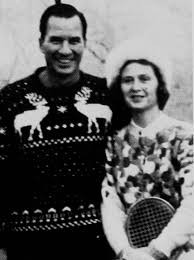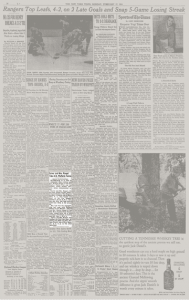Carver, A. H. (Zan)
Carver was the number one tennis player at the University of North Carolina and from there went on the tennis circuit as an amateur. He played at the premier United States Tournament, the Nationals at Forest Hills, six times in 1940, 1944, 1946-1948, and 1952. In 1944, he played his way to the quarterfinals, disposing the eighth seed in the round of 16 to get there. He emerged from Forest Hills that year ranked 11 nationally.
Zan was such a dedicated tennis player that, when he was exposed to platform tennis, he continued to play tennis year round because he was afraid that paddle might be detrimental to his strokes. This has been a fear often-voiced fear by tennis players, but he was living proof that that isn’t the case. He adopted our non-resilient, short handled paddle in the off-season and went on to become a leading proponent of the game. He introduced at least four crack tennis players—Don Budge, Don McNeill, Chuck McKinley and Jack Kramer—and, one movie star, Charlton Heston, to platform tennis. He not only played, promoted, and loved the game—he won at the game.
A three time winner of the Men’s Nationals with Dick Hebard from 1961-1963 Carver and his partner were one of five teams in history to win three or more times, and one of four teams so far to turn the platform tennis “hat trick” of winning three times in a row. Zan also won the Mixed Doubles in 1964, and was runner-up four times in 1958, 1962, 1963 and 1968. He was a two-time winner in the Men’s Seniors in 1963 (45+) and 1970 (50+), and was a finalist in that event in 1968. He is also ranked third among male players in the number of Tournaments in which he has been a finalist.
In all of this, Carver showed his highly tuned ability and competitiveness. All his shots were good, but his best was probably his return of service, which was powerful and consistent. Not consistent in the sense of it being hit to the same place or at the same speed, but consistent in deftness and authority and in its absence of errors. In fact, Zan’s entire game was characterized by absence of errors. He was also highly skilled at the half volley and was also extremely successful at bringing the center court theory of tennis doubles to platform tennis.
Tales of his sportsmanship were legend, and in a game where this quality abounds, this man’s selflessness consistently stood out.
Source: Adapted from Induction Speech, as printed in the APTA Annual Meeting Minutes Nov 5th 1970

 SCARSDALE, N. Y., Feb. 16 —Alexander (Zan) Carver and Mrs. William Koegel of the Fox Meadow Tennis Club won the national mixed doubles platform tennis championship today.
Carver and Mrs. Koegel, who had been seeded second, defeated James Gordon of Fox Meadow and Mrs. J. Warren Lee of Short Hills, N. J., who headed the draw at the Fox Meadow Courts, 8–10, 11–9, 6–1. Gordon and Mrs. Lee held match point four times in the second set.
Mrs. Lee won the championship last year with Richard Hebard of Fox Meadow. Hebard and Mrs. Rawle Deland of the Wee Burn Country Club, Darien, Conn., seeded third, lost in this morning's semi‐finals to Gordon and Mrs. Lee, 6–2, 6–2.
Carver and Mrs. Koegel, who reached the final last year, defeated John Beck and Mrs. William Wasch, also of Fox Meadow, 6–3, 6–4, in the other semi‐final.
SCARSDALE, N. Y., Feb. 16 —Alexander (Zan) Carver and Mrs. William Koegel of the Fox Meadow Tennis Club won the national mixed doubles platform tennis championship today.
Carver and Mrs. Koegel, who had been seeded second, defeated James Gordon of Fox Meadow and Mrs. J. Warren Lee of Short Hills, N. J., who headed the draw at the Fox Meadow Courts, 8–10, 11–9, 6–1. Gordon and Mrs. Lee held match point four times in the second set.
Mrs. Lee won the championship last year with Richard Hebard of Fox Meadow. Hebard and Mrs. Rawle Deland of the Wee Burn Country Club, Darien, Conn., seeded third, lost in this morning's semi‐finals to Gordon and Mrs. Lee, 6–2, 6–2.
Carver and Mrs. Koegel, who reached the final last year, defeated John Beck and Mrs. William Wasch, also of Fox Meadow, 6–3, 6–4, in the other semi‐final.



